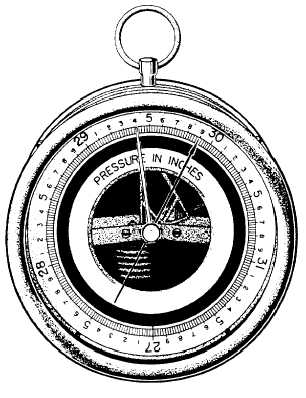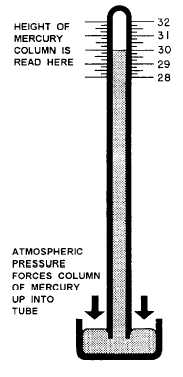Figure 9-8.-A mercurial barometer.
Figure 9-7.-An aneroid barometer.
Mercurial Barometer
Since air pressure affects weather, you can see why
the use of a barometer is so important to ships. However,
not so apparent is the importance of air pressure in the
operation of the ship’s engine. For that purpose air
pressure is measured with a gauge called a manometer.
Aneroid Barometer
The aneroid barometer shown in figure 9-7 is an
instrument that measures air pressure at sea level. It
consists of a thin-walled metal box from which most of
the air has been pumped and a dial indicating low- and
high-pressure measurements. A pointer on the dial is
connected to the box by a lever system. If the pressure
of the atmosphere increases, it squeezes the sides of the
box. This squeeze causes the pointer to move toward the
high-pressure end of the dial. If the pressure decreases,
the sides of the box expand outward. That causes the
pointer to move toward the low-pressure end of the dial.
Notice that the numbers on the dial are from 27 to 31.
This scale of numbers is used because average sea level
pressure is 29.92 inches and readings below 27 inches
or above 31 inches are rarely seen.
Figure 9-8 illustrates a mercurial barometer. It
consists of a glass tube on which measurements are
indicated; the tube is partially filled with mercury. The
upper end, which is closed, contains a vacuum above the
mercury. The lower end, which is open, is submerged in
a cup of mercury that is open to the atmosphere. The
atmosphere presses down on the mercury in the cup and
pushes the mercury up in the tube. The greater the air
pressure, the higher the rise of mercury within the tube.
At sea level, the normal pressure is 14.7 psi, and the
height of the mercury in the tube is 30 inches. As the air
pressure increases or decreases from day to day, the
height of the mercury rises or falls. A mercury barometer
aboard ship mounts in gimbals to keep it in a vertical
position despite the rolling and pitching of the ship.
The dial of most gauges indicate relative pressure;
that is, it is either greater or less than normal.
Remember-the dial of an aneroid barometer always
indicates absolute pressure, not relative. When the
pressure exerted by any gas is less than 14.7 psi, you
have what we call a partial vacuum.
Manometer
The condensers on steam turbines operate at a
pressure well below 14.7 psi. Steam under high pressure
9-6



